The silver arowana, also known as the osteoglossum bicirrhosum, is a metallic hued predatory fish native to South America. Their scientific name, osteoglossum bicirrhosum, quite accurately describes its appearance. Osteoglossum translates to “bone-tongued” and bicirrhosum is “two barbels”. Where are silver arowanas from? This tropical fish can be found swimming in basins and certain rivers near the Amazon.

Table of Contents
Silver Arowana Overview
In the aquarium world, the silver arowana is also known as the Monkey Fish or Dragon Fish. We assume they are named after the fierce mythical creatures due to their appearance and they pay homage to monkeys by the way they jump out of the water to catch their prey at times. Since they are predatory, they do require a large tank and extra thought into suitable tankmates. They aren’t the easiest fish to handle which is why they are less recommended for beginners.
They might not look like much to the untrained eye, but for many aquarists around the world, the silver arowana osteoglossum bicirrhosum is a coveted and beautiful fish that many would love to add to their tank.
| Information Chart | Silver Arowana |
|---|---|
| Care Level: | Difficult |
| Temperament: | Semi-aggressive |
| Color: | Silver |
| Lifespan: | 10 to 15 years |
| Size: | 3 feet maximum |
| Family | Osteoglossidae |
| Diet: | Carnivorous |
| Minimum Tank Size: | 250 gallons |
| Temperature: | 75-82 ºF (24-28 ºC) |
| Water Conditions: | pH 6.5-7.5 |
| Tank Mate Compatibility | Peaceful fish that can be aggressive when necessary |
Silver Arowana Care Level
Their predatory nature makes them difficult to care for at times. They show aggression and are very powerful swimmers. If you intend on keeping a silver arowana, get ready to compromise on space. Aside from being powerful in water, the silver arowana can also survive for brief periods out of their element by utilizing their swim bladders.
To really understand the amount of work that goes into taking care of silver arowanas, just think about their size, temperament and their susceptibility to poor water quality. You need to be on your toes quite a lot to ensure proper care for silver arowanas. This means a lot of tank maintenance.
If you have other fish in the aquarium, especially small species, it would be a good idea to understand whether or not they would be a good match first. How much is a silver arowana? They usually come at around $40, with the silver arowanas being the cheapest of all the arowanas. Is the silver arowana a lucky fish? Well, in Chinese culture, the arowana species do bring some luck!
Habitat In The Wild
As per the experts, this Osteoglossidae family representative can be seen in almost all the continents: South-East Asia, Australia, Africa, and South America. Do you know what a major reason behind this is? These fish are ancient. During the Jurassic time, their predecessors were called Gondwana.
They are commonly found in river basins of South America, like Essequibo, Rupununi, Amazon River, and the Orinoco. Silver Arowanas generally inhabit backwater and river inshore zones. Besides, they also love to live in lakes where the water temperature is around 24 to 30-degree C.

You can recognize these species from their appearance. They have a long straight back and giant mouth. The dorsal, combined with the tail and anal fin, create a strong paddle that lets them move smoothly.
While swimming upstream, the fish curve the body from one side to another. A Silver Arowana has two small sensitive barbs that can sense small vibrations made by insects or other things. When they detect any prey, they jump at it and swallow it. As these fish are great jumpers, some people have named them monkey fish. It has also been seen that they can jump much higher enough to catch small birds.
Silver Arowana Behavior and Temperament
We mentioned that the silver arowana fish is very powerful and fierce, but what’s funny is that they do scare more easily than you think. Think of them as scared little children that startle each time you make any sudden movements. Even turning on the light suddenly or any jerky movements can be enough to give them a scare.
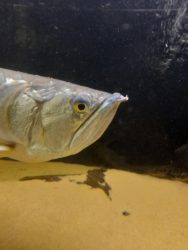
Being constantly on-edge will do no favors for your silver arowana’s well-being, and this is why we recommend placing their tank in a place that’s out of the way and sees less traffic. Even when someone just walks by the aquarium can be a problem, so really put some extra thought into where you place them.
You should probably think about having your aquarium covered. Like we mentioned before, silver arowanas are quite the jumpers. This is due to their natural behavior of jumping out of the water to catch insects and other prey. Some have even said they can jump as high as a couple of meters! As you can see, this can be a problem in domestic environments.
It’s worth it to note that even with a lid, the silver arowana osteoglossum bicirrhosum will still try to spring free in an aquarium that’s too small. This may result in them injuring themselves against the lid. The best way to avoid this behavior is to make sure you provide them with an aquarium of a suitable size.
This will happen even more so if the aquarium is too small. They will feel trapped and try to jump closer to the surface. Speaking of the surface, silver arowanas are surface swimmers, meaning they spend most of their time close to the surface.
Silver Arowana Appearance
The silver arowana is considered a real prize in the fish keeping world. Their large size and silver-colored scales make them a real beauty. One of the most defining features about the silver arowana osteoglossum bicirrhosum is the almost vertical mouth. This makes it seem like they are perpetually unhappy about something, which is quite an amusing feature.

They possess dorsal and anal fins that are small that extend down the entire length of the bottom half of their body and almost fuses with the caudal fins.
The young Silver Arowanas come with bright yellow-orange stripes, and some also have blueish glitter on the strips. The fish’s anal fin and dorsal are quite narrow and long. They can coalesce with the fluke.
Using their flattened and wide tail-stem, they create paddles. Well, you may find that unusual, but that paddle gives them a perfect boost when they attack their prey. They can jump quite high. Some aquarists have reported that their Arowana can jump more than 3 meters high.
In most fish species, the anal fin has around 49 to 58 rays and 40 to 50 rays in the dorsal fin. In the case of Arowanas, they have more than 90 spinal bones, and on the lateral line, you will find around 30 to 37 scales.
A Silver Arowana can also live for a long time in oxygen-deficient water. The fish likes to live in thickly planted water in its natural habitats. They have developed multiple ways to breathe. Its air bladder has a large net of tiny blood vessels that make sure it works as a lung and properly dissolves oxygen in the blood.
Silver Arowana Size
In the wild, these amazing beauties can grow to be about 4 feet! That’s why they need plenty of room to swim in their aquarium. However, in captivity, they grow up to about 3 feet, which is still exceptionally large. Sexing them is also not very difficult since the females are more voluptuous compared to the males who are generally thinner. One other distinguishing feature is the larger anal fin on a male arowana.
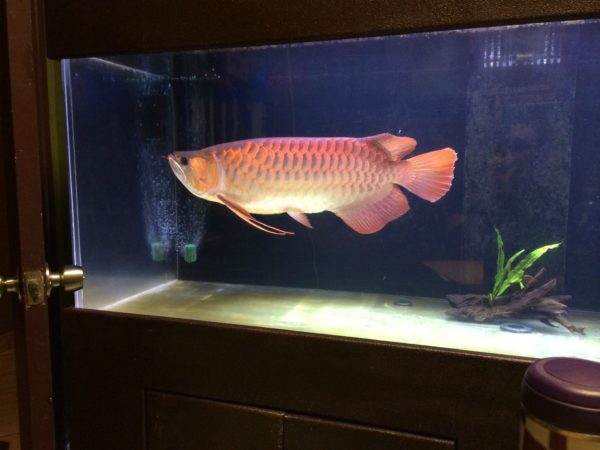
They start out quite small but grow about 2 inches every month for their first year, which is why you need to account for their fast growth rate when picking out a tank.
Color
The silver-colored wonders earn their name with their silver scales. However, before maturity, silver arowanas will have more of a bluish hue to them.
Lifespan of Silver Arowana
Sadly, the lifespan of these domesticated arowanas are no match for the ones in the wild. However, even then they can still live for a pretty long time, ranging anywhere from 10-15 years! There are a lot of elements that contribute to whether they are on the lower or higher end of the spectrum, and those elements include diet, aquarium conditions, and care.
Feeding Silver Arowana
Speaking of diet, let’s take a look at what the arowana eats. Scarily enough, arowanas are considered to be carnivores! Since they also have a varying diet, they can be considered omnivores as well. In the wild, their diet consists of insects, smaller fish, snails, and even rabbits and snakes! We are just as surprised by the last two as you are.
However, the latter part of the list isn’t exactly part of their usual diet. In general, the arowana still prefers other fish, insects, and even small crustaceans. The unique shape of their mouths also gives arowanas an advantage when hunting.
They dwell on the surface to wait in the wings and as soon as something delicious lands on the water, they scoop it up with their mouths like a spoon.
To give your arowana the best care, you need to make sure its diet is as close to what it prefers in the wild as possible. As said, they are considered mostly carnivores, which is why you should focus their diet on a meat-based meal plan. Look at incorporating earthworms, crustaceans, and even some beef.
Breeder fish is also a great idea because this will simulate a natural environment and allow them to hunt the way they would in the wild. They like to search for insects and fish, so why not give them that opportunity? You can even consider feeding them frozen meat if you are worried about the food quality in aquarium stores.
Arowanas aren’t commonly fed pellets, but they can be trained to accept it if the occasion calls for it. Due to their type of diet, it’s not very common to be able to feed an arowana with a fish feeder. It’s also useful to note that immature arowanas can be picky eaters. It’s best to give them a varying diet of fresh food at this time.
Family
The silver arowanas belong to the Osteoglossidae family and are freshwater fish indigenous to South America.
Silver Arowana Care & Tank Set-Up
Tank Conditions for Silver Arowana
Arowanas are amazing fish of a large size and are very powerful as well. It’s important that their aquarium setup needs to reflect that. Their tanks need to be large enough to give them free swimming space and it should also be covered to prevent jumping and escaping.
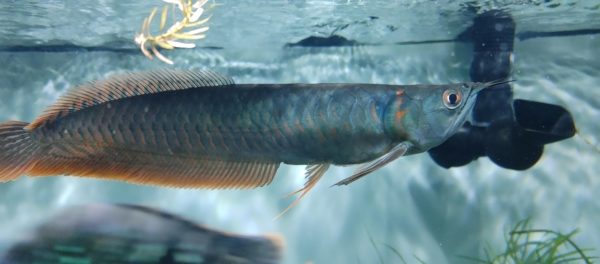
Babies can be raised in smaller tanks, but because they grow so quickly and changing the tank can be a real pain, so we suggest investing in a large tank from the get-go.
Substrate you should place in the tank include plants, rocks and driftwood. Now it’s still very important here to ensure the arowana is ale to live in an environment that reflects the Amazon. There shouldn’t be too many plants to limit their roaming space so plant everything sparsely in the tank.
Since they are such powerful swimmings, any plants that don’t hold well (have weaker roots) can be easily torn up and dislodged by the arowana.
Temperature
The most ideal temperature will also be slightly warmer, due to being from the Amazon. We’re looking at anywhere between 75-82 degrees Fahrenheit or roughly 24 to 28 degrees Celsius.
Water Conditions
Arowanas are particularly sensitive to water changes and poor water quality. This is why you need to invest in a top of the line filtration system and change 25% of the water weekly. It’s a lot of work, and the arowana isn’t easy to care for but their beauty and majesty make it worth it.
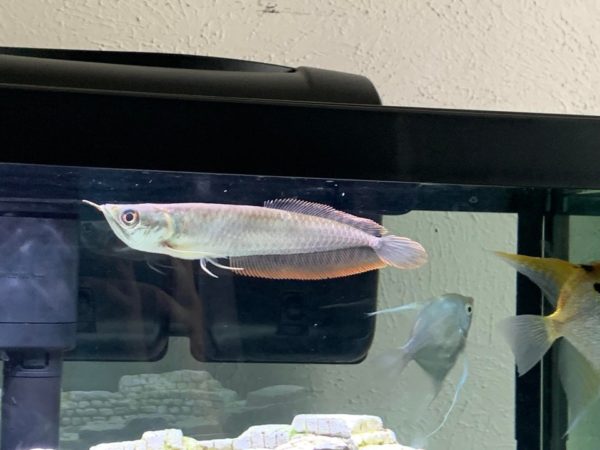
The wild silver Arowana prefers to live in soft water with a pH level ranging from 6.0 to 8.0 pH level. However, while living in a tank, they are not demanding the tank’s water chemical content. They can easily adapt to any tank water condition with a wide range of acidity and hardness.
The tank water temperature should be around 24 to 28-degree C, making sure it is close to 26-degree C.
Minimum Tank Size
Depending on how many arowanas you keep, you are looking at a minimum tank size of 250 gallons for one! That will take up quite a bit of space so it’s important to make sure that you have enough space.
One of the most crucial conditions to be considered while keeping the Silver Arowanas in an aquarium or tank is the size of the tank. The professional aquarists’ recommended tank size is around 134 gallons or more than 500 liters.
The minimal tank size should be at least 5 cm high, 60 cm wide, and 160 cm long. They are long fish, and the tank should have enough space to turn easily. The perfect tank size for Silver Arowana should be decided considering this formula: the length of the fish aquarium should be around three times larger than your Silver Arowana. On the other hand, the width of your tank should be less than 1.5 of your fish sizes.
For a temporary period, you can keep young Silver Arowana in small tanks for a temporary period. But they grow quite fast, and later you will have to transfer them into a well-sized tank to prevent the body deformation issue and to ensure their maximum body length and lifespan. Besides, you should keep the tank close using a glass cover so that your fish can’t jump out.
Well, Silver Arowana spend most of their time dwelling at the surface area, so the depth of your tank may not be a crucial factor for them. However, you should use a cover as they can instinctively try to catch their prey.
Tank Maintenance and Care for Silver Arowana
The large tank size alone makes maintenance and care difficult, especially considering that you need to change the water every week. You also need to make sure you are feeding them the right kind of food and since their diet consists mainly of live food, you need to clean out the leftovers immediately. The rotting carcasses of the leftover food can really alter water conditions.
Suitable Tank Mates for Silver Arowana
They are fish that can take up most of the space in a tank, so if you are considering tank mates, you need to make sure the other fish plus the arowana itself has enough room. They are predatory creatures, which means that a lot of the smaller fish kept with them can easily become prey. As young fry, they are actually more susceptible to being bullied by other more aggressive fish than being the bullies themselves.
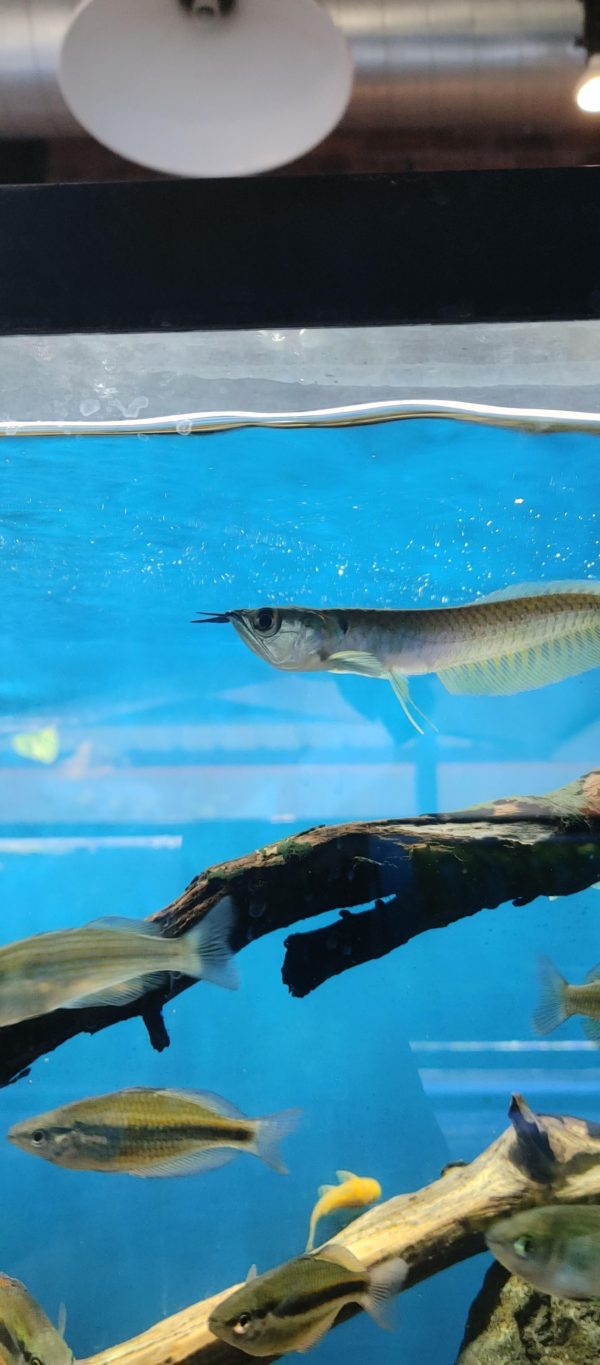
If you plan on adding a young arowana, then it will be the other fish you are worried about. Arowanas are also suggested to be kept in groups as well, this is to help the band together against more aggressive fish. Although, when they reach maturity, they are usually the dominant ones in the tank.
Compatibility
Think about these deciding factors when considering fish mates for your arowana. You don’t want another predatory species, but you do want them to be able to hold their own when necessary. Therefore, you should look for peaceful yet slightly aggressive fish such as angelfish or catfish.
Their tank mates also need to be large enough to not fit easily in the arowana’s mouth. Fish that they can gulp down in a single bite will definitely end up being food. Fish are individuals as well and they have their own personalities, so don’t be surprised if they don’t always become friends.
Breeding Silver Arowana
Arowanas spawn during the colder months for us, which is December and January. Silver arowanas are what we call mouthbrooders, which means the parent (the male/the dad) takes the eggs and keeps them in his mouth. This happens after the females have laid them in the nest first.
Breeding arowanas can be difficult due to the amount of space they need and most of the captivity breeding success stories have occurred only on fish farms or places with tanks or ponds larger than 500 gallons! Think about all the space you would need after hatching. Remember that the fry grow very quickly, which is why indoor breeding is also advised against.
Is The Silver Arowana Good For Your Aquarium?
Before diving into this matter, there is one thing that you should keep in mind: Silver Arowanas are not perfect for beginners. As mentioned above, they have a long life expectancy and are quite large. That’s why only experienced, and professional aquarists can deal with the possible challenges.
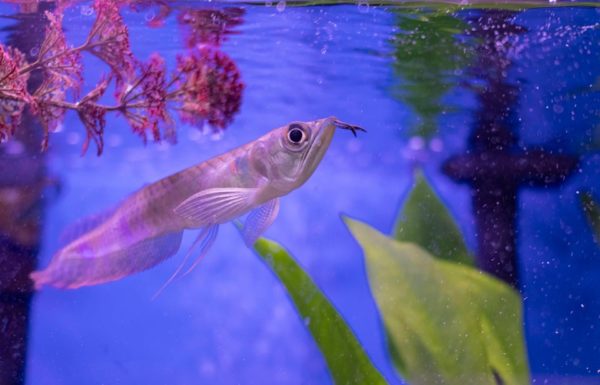
Your Silver Arowana will require a huge aquarium with a minimum 250 gallons water capacity. On the other hand, it can be very challenging to find some suitable tankmates for your Silver Arowana.
These species are carnivores and can consume large quantities of fish foods. Before planning to buy them, you should consider this thing.
Regarding the price, if you are looking for the cheapest Arowana species for your home aquarium, you can choose Silver Arowana. A small one will cost you around USD 30 to USD 40.
Well, if you think you can meet all these requirements and are planning to get one, then it is advisable to get one when the Silver Arowana is around 7 to 8-inches long. During this time, they will be a little harder, and you can successfully keep them.
Interesting Facts About Silver Arowana
- They utilize their barbels as a sensory organ to detect their prey. So, you should avoid using gravel and other surfaces that can damage their barbels.
- They are from the Jurassic Era, and they look quite the same now as they did during that time.
- A Silver Arowana in a suitable living environment can grow around 30 to 47 inches.
- The scientific name Osteoglossum Bicirrhosum means bone-tongued and two barbels.
- They are excellent jumpers and hunt, and they can easily jump around 5 to 7 feet above the water level. They swim in snake-like motion.
- Silver Arowanas remain active during the day, unlike the Redtail Catfish.
- They are omnivorous fish and can eat small birds, aquatic insects, fish, plant matter, and more. They can also eat snakes and turtles.
- Silver Arowanas are quite good at recognizing their owner. You can easily train them to take food from your hand.
- Male Silver Arowanas keep the fertilized eggs for around fifty to sixty days in their mouth for hatching.
- In captivity, they can survive for 10 to 20 years, and in the wild, they can easily survive for more than 20 years.
Well, Silver Arowanas are important sources of food for some local communities. But the population of these fish is still stable and large.
Silver Arowana Fish Diseases And Treatments
Remember that Silver Arowanas are quite expensive water pets to take care of. Even though the water and tank condition is good, the different diseases can infect and affect your fish once their resistance to the diseases is low. Apart from insufficient care, parasites, bacterial attacks, and contamination can affect health. Here are some common health issues that Arowana can suffer from.
- Tail and Fin Rot
Your fish will develop grayish or white spots around the fins or gills and on the head. With time, it will become more brownish or yellowish. Some called this saddleback. Fin Rot in this fish is generally caused by rod-shaped, aerobic, and Gram-negative bacterium Flavobacterium columnar. Most aquarists mistake it for a fungal infection.
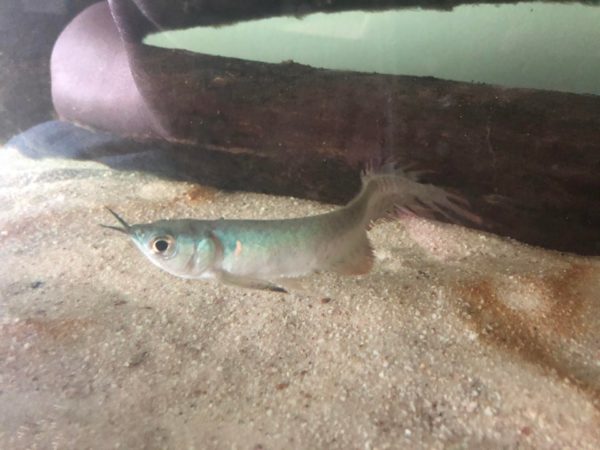
However, the condition is treatable. First, change the tank water as soon as possible and use anti-columnaries medication following the recommended dosage. Don’t try anything that can increase the water temperature as the bacteria will be more active with the rising temperature. If you think the condition is improving, change around 30 percent of water and apply the medication again.
- Hemorrhagic Disease
When your fish has this issue, the swelling or wound will be visible on the body caused by rubbing the barbels against the aquarium’s wall. This disease is quite common among the Silver Arowana, who frequently rub their filament. If it scraps the tissue, it leads to inflammation and swelling. If your aquarium has contaminated or bad water, the process will speed up.
To avoid such issues, you need to offer your fish a well-sized tank considering its size. Besides, while anesthetizing the Silver Arowana, you should use the right Arowana medication. Do it properly until it is anesthetized. Using any fish sterilized tool, gently and carefully remove the growth of the infection. After that, you can use powders developed for fish to prevent the spread of infection.
- Dropsy
It is not a disease; it is a symptom related to multiple underlying health issues, including liver dysfunction, parasitic infections, and bacterial infections. It is also called Edema or Pinecone. This is generally developed due to bacterial infection in the kidneys.
As your fish becomes weak, it can get infected by the pathogen. Speaking about treatments, you can try by treating water with Magna salt. If you don’t know much about this, they prefer to talk to an expert and follow the recommended dosage. Besides, you should always follow a good water change routine.
You should always keep the tank clean and don’t feed them difficult to digest. If your fish has been infected, quarantine it into a separate tank to keep other fish protected. Keep your aquarium sanitized by using good chemical and medical additives. By doing this, you can prevent the growth of bacteria in the tank.
FAQ
Do Silver Arowanas Need Light At Night?
No, Silver Arowanas don’t need light, and during the night, you should turn it off. Remember that leaving the aquarium light on can lead to stress as they need darkness to sleep. Besides, too much light can allow the algae to grow rapidly, and your fish tank will look dirty. So, don’t keep your light on.
Is Silver Arowanas Hard To Keep?
Arowanas can live more than two years in your aquarium in good living conditions. Well, this is more than any domesticated pets, like cats or dogs. Besides, they eat a lot. So, keeping all these things in mind, it can be said that keeping a Silver Arowana is like a long-term commitment, and for some, this can be a little challenging.
What Are The Right Foods For A Silver Arowana?
Well, you can train your Silver Arowana to eat fish food pellets. However, some prefer a meaty diet. However, speaking about some of the best foods, you can give earthworms, shrimp, crab meat, beef heart, and more.
How To Know If Your Silver Arowana Is Happy Or Not?
If they are swimming actively across the talk and not lying at the bottom, then your Silver Arowana is happy. Some other signs to consider are: eat regularly, and during feeding time, they will quickly swim to the surface, not white spots on the body, no ragged fins, and expand the gills frequently.
We think you may be interested in: Best Pond Liner
Conclusion
Are silver arowanas right for you? The arowana is a beautiful and unique fish that requires a lot of care. If you have the space and the time to properly monitor the tank conditions and keep them on a diet similar to their natural one, arowanas are prize-winning fish to add to your collection.
Many people are like a dream fish that is considered the ultimate fish keeper’s goal. They are magnificent predators and stunningly beautiful. In a perfect environment, any aquarist can have one.
But you should not forget the special requirements for your Silver Arowana mentioned above. For instance, more food, large tanks, anda a heavy tank cover. However, Arowanas are rewarding and worth every penny you have spent on them.
No related posts.

1 thought on “Silver Arowana Care: Diet, Health, Tank Setup, and Diseases”
It’s interesting. Thanks for your sharing. I have also kept Arowanas in the tank and my fish is not too big. And thanks to its winding swimming lines, the aquarium looks more attractive. I usually feed baby Arowana live worms, small fish, or insects. Then gradually change their diet to protein-rich pellets or worms or freeze-dried shrimp. And I was amazed at how the Arowana’s color changed when I fed it the right Arowana food.